Introduction of Auditorium
An auditorium is a large, enclosed room built to enable an audience to attend live lectures, stage performances, concerts, and other gatherings. There are many types and forms of auditoriums that can vary depending upon the type of function, purpose, volume, size, and shape. For example, auditoria spaces suitable for music will be different from spaces for drama, dance, music theater, opera, or even conference use. The scale of space in terms of seating capacity may further accentuate the form of the auditorium.
Auditoriums typically features a stage or platform for speakers and performers, back stage area for performers and there team, seating for the audience, and acoustics designed to enhance the sound quality of the performance or presentation. It is basically a large room or space that is used to accommodate an audience in a building (which can be of any type). All the seats in the auditorium face the stage, where they attend live lectures, performances, drama, seminars, larger meetings, community events, and other occasional functions.
Auditoriums can be found in a variety of buildings, such as schools, universities, concert halls, theatres, and conference centers.
Auditorium Design Consideration/Parameter.
Site selection and planning
- The location of an auditorium is determined by many different factors, some of which may be mutually contradictory, but a compromise must be reached between the various concerns involved. The issue of noise is vital to consider.
- A noise survey of the site should be made in advance so that noisy locations are avoided where possible. as otherwise elaborate and expensive construction may be required to provide the requisite sound insulation. (Source: IS Code: 2526 )
Size and Shape
- The size should be fixed in relation to the number of people required to be seated.
- The hall’s floor area, including gangways (but excluding the stage), should be computed at 0.6 to 0.9 m2 per person.
- The hall’s height is controlled by several factors such as ventilation, the presence (or lack) of a balcony, and the sort of performance.
- The average height for small halls ranges from 6 m to 7.5 m for large halls. (Source: IS Code: 2526 )
- Auditorium standard area per person or seats should be between 1.5 to 2.0 m2.
- Auditorium Standard dimensions and layout: Dimensions can be challenging, but a decent rule of thumb is to size the auditorium based on the style of performance and the number of audience members you intend to seat:
- 200 seats: 270 m2 (2900 ft2)
- 150 seats: 190 m2 (2000 ft2)
- 75 seats: 125 m2 (1350 ft2) [3]
Audience Requirements
- Within the auditorium, the critical relationship between the audience and the performer is with the stage and what’s happening there.
- The audience should be able to clearly see and hear whatever is happening on every part of the stage or platform. [Metric Handbook, 6th Edition]
Visual Limitations
It is determined by the maximum distance from the platform at which the audience is able to appreciate the performance and for the performers to perform in front of the audience. This distance varies according to function type and the scale of the performance:-
- For Drama: The most important thing is to recognize the facial expression and act of the actors. That’s why the most distance ought to be 20000 mm (70 ft) from the setting line of the proscenium stage or the geometric center of the open stage.
- For opera and musicals: Here the facial expressions and other things are not critical, that’s why the distance can be 30000 mm (100 ft).
- For dance performances: The facial expressions are less important, but the audience should appreciate the whole body and discern choreographic movement patterns. That’s why the distance should not exceed 20000 mm (70 ft).
- For full-symphonic concerts, acoustic conditions predominate.
- For chamber concerts: Acoustic conditions and visual definition both predominate. Visual definitions assist in achieving intimate settings.
- For conferences, speakers, and lecturers: There are two scales, the first captures the facial expressions that restrict them to 2000 mm (70 ft), and the second is a large scale where facial expressions are not necessary, just the audiovisual projection.
- For slides, video, television, overhead projectors, and other projections, visual limitations can be determined by various technologies. [Source: Metric Handbook, 6th Edition]
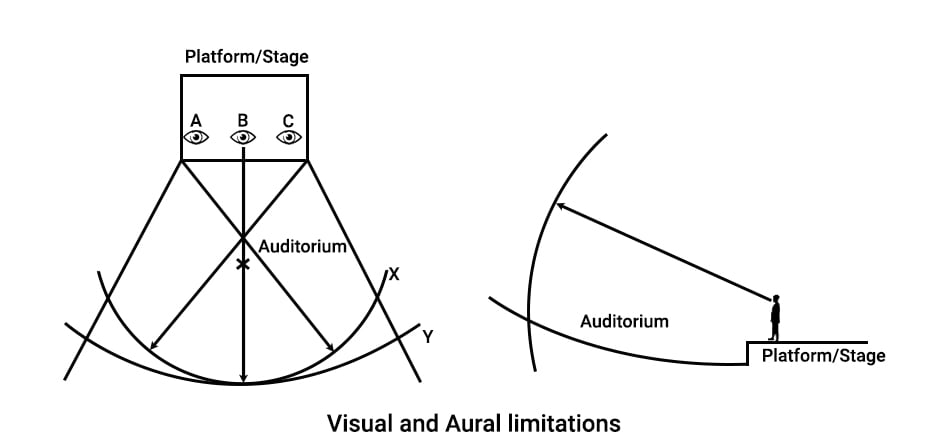
Aural Limitations
- This refers to the distances across which speech, singing, and music can be clearly heard without the need for amplification and beyond which they cannot.
- For drama, opera, and classical music, amplification is deprecated, but it is acceptable.
for variety and pantomime, and essential for rock music. - For amplified sound, the auditorium requires a dry or dead acoustic with no reflected sound from the platform or stage and limited or no reverberation. Loudspeakers are positioned to provide full and even coverage of the audience.
- The volume and quality of the unamplified sound are dependent on the volume, shape, size, and internal finishes of the auditorium and its resultant reverberation time.
- As an initial guide, a volume in the order of 10 m3 per seat should be allowed, but the dimensions and acoustically reflective surfaces of the space for music must also be considered. [Source: Metric Handbook, 6th Edition]
Levels in the auditorium
- Seating gradients in an auditorium are determined by calculating the sightlines from each row to the stage or platform.
- With a single level, the pitch of the rake requires particular attention to achieve a sense of enclosure for larger audiences relative to the stage.
- Within aural and visual limitations, an alternative means of increasing seating capacity can be the addition of one or more balconies within the overall permissible volume of the auditorium.
- Boxes, side galleries, and loges can also be added to the side walls, particularly in the proscenium style. [Source: Metric Handbook, 6th Edition]
Seating Requirements
Seating Geometry
In Auditorium seating is often arranged in straight or curved rows that face the platform or stage.
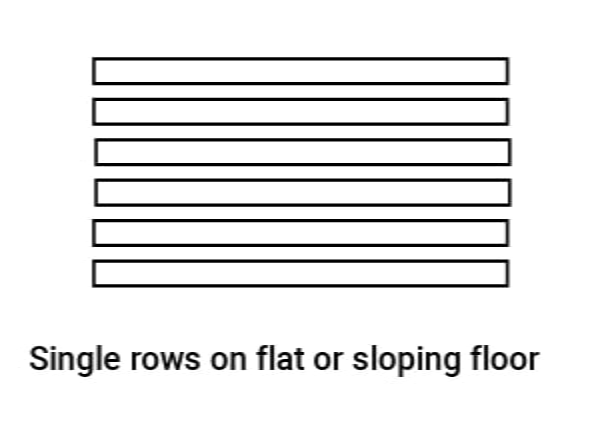
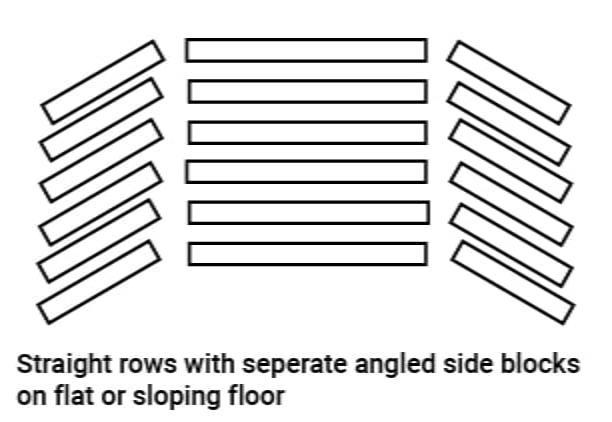
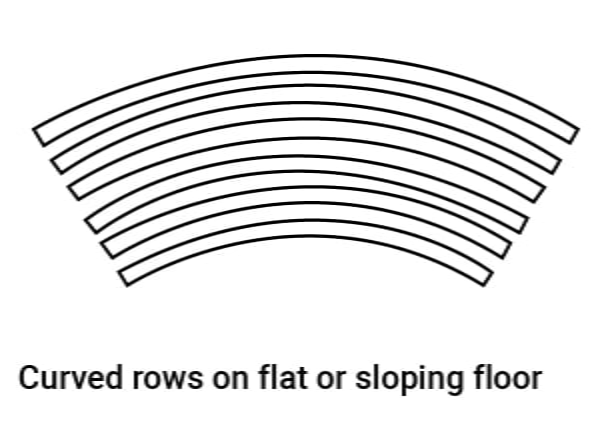
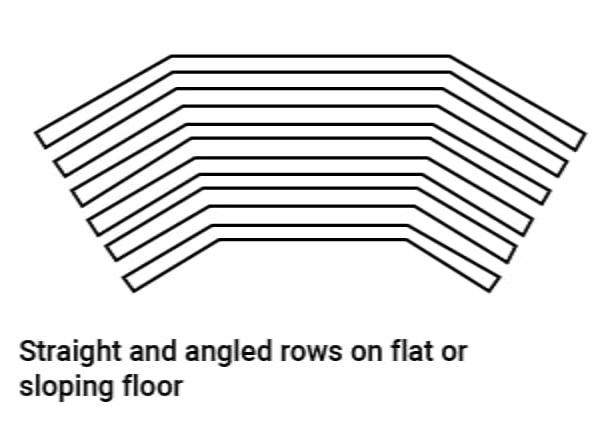
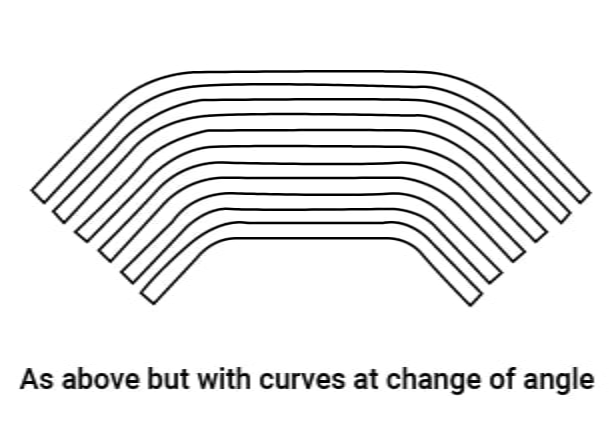
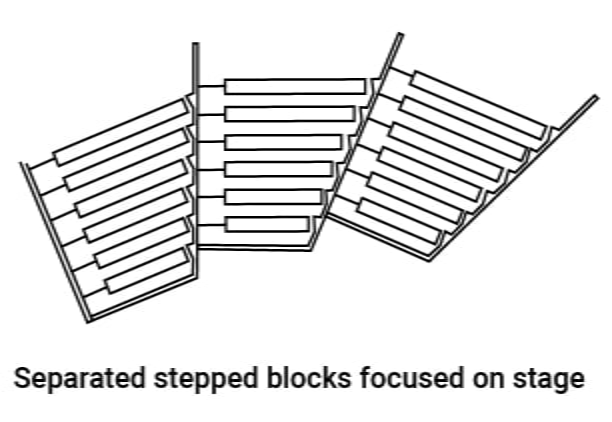
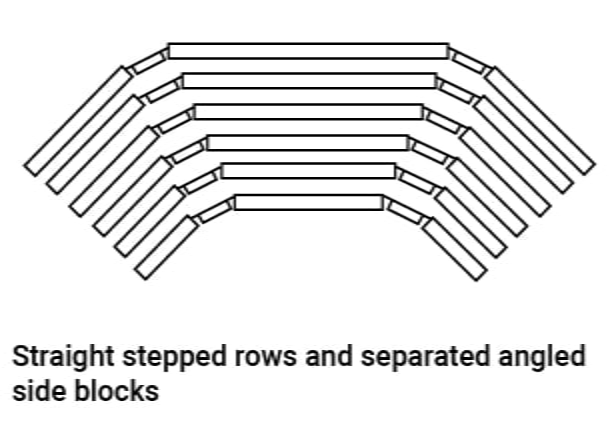
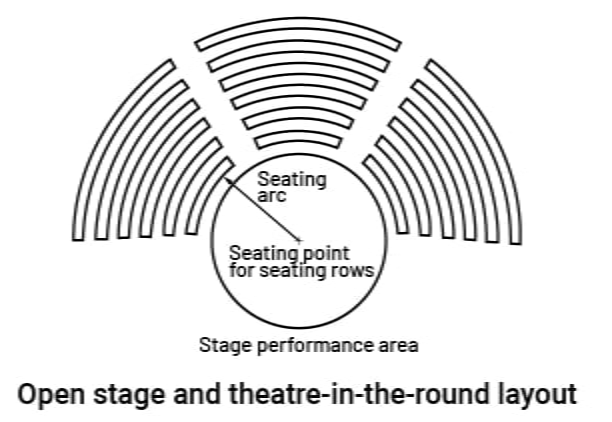
Seating Module
Auditorium seating broadly falls into the following categories:
- Benches, with and without backs
- Fixed seats, with or without arms
- Tip-up seats, with or without arms
- Conference seats with a writing top and wired communication services. [Source: Metric Handbook, 6th Edition]
No. of seats in a row
- Traditionally, the maximum number of seats in a row is 22 (for rows with gangways at both ends) and 11 (for rows with a gangway at one end).
- Rows with more than 22 seats are allowed, but if the audience is not thereby imperiled in any situation.
- A maximum of 16 seats per aisle is allowed to plan. 25 seats per aisle is permissible if one side exit door of 1200 mm (4 ft.) width is provided per 3–4 rows. [Source: Metric Handbook, 6th Edition]
| Seatway width in mm | Maximum number of seats in a row with gangway on one side | Maximum number of seats in a row with gangway on two sides |
| 300 to 324 | 7 | 14 |
| 325 to 349 | 8 | 16 |
| 350 to 374 | 9 | 18 |
| 375 to 399 | 10 | 20 |
| 400 to 424 | 11 | 22 |
| 425 to 449 | 12 | 24 |
| 450 to 474 | 12 | 26 |
| 475 to 499 | 12 | 28 |
| 500 or more | 12 | limited by travel distance to a place of safety |
Row to Row Spacing
- The minimum unobstructed space for individuals to pass along the row in traditional seating is 400 mm (16 inches), and this dimension can change with the number of seats in a row.
- For Continental seating, the clear space is not less than 400 mm (16 inches) and not more than 500 mm (20 inches).
- The minimum row-to-row dimension required by standards is 850 mm (34 inches); however, this is frequently insufficient, and the minimum for traditional seating should be 900 mm (36 inches). [Source: Metric Handbook, 6th Edition]
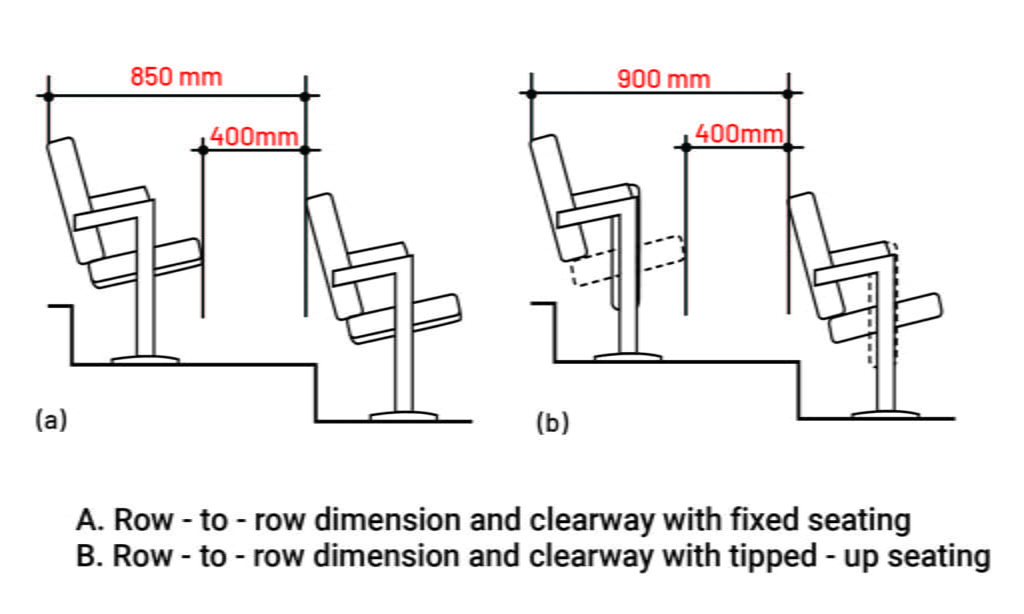
Seating Density
- The seats should be positioned in concentric arcs of circles, with the center as far behind the curtain line center as the curtain line distance from the auditorium back wall.
- The width of an auditorium seat should be between 450 mm and 560 mm. [Source: IS Code: 2526]
- Seats with arms and a tip-up seat can be as little as 500 mm (20 inches) wide (for seats without arms, such as benches or individual seats, this can be as little as 450 mm (18 inches) wide) with a row-to-row dimension of no less than 750 mm to 900 mm (30 to 36 inches). However, seats can be as huge as 750 mm (30 inches) broad by 1400 mm (56 inches) long.
- The area per seat therefore varies between 0.38 m2 and 3.05 m2. Increased dimensions reduce seating capacity and audience densities.
- Minimum proportions established by authorities provide a relatively modest degree of comfort and should not be considered the norm, but if the criteria are too high, the audience’s social cohesion may suffer. [Source: Metric Handbook, 6th Edition]
Sightlines for a seated audience
Every individual inside the audience needs to have an uninterrupted view of the stage and the performance happening there. The heads in front and clear of the overhangs need to be studied with 3D modeling to set the boundaries for good vertical and horizontal sightlines.
Vertical Sightlines
- The elevation is based on the argument that each listener should be elevated in relation to the person in front of him such that the listener’s head is about 120 mm above the path of sound that would pass over the person in front of him. [2]
- P (Point of Sight) is the lowest and closest point of view for the audience on the platform or stage. Its position can vary considerably, both vertically and horizontally, depending on what must be seen in the performance or presentation.
- HD (Horizontal Distance) refers to the horizontal distance between the eyes of a seated individual and can range from 760 mm (30 inches) to 1150 mm (46 inches) or more.
- O (Offset) is the horizontal distance between the position of the eye and the position of the riser or step.
- EH (Average eye height) is 1120 mm (45 inches) above the theoretical floor level; the actual eye point will depend on seat dimensions.
- E (Eye level to head) is the distance between the center of the eye and the top of the head, and it is typically considered 100 mm (4 inches) for the purpose of sightline calculations. This dimension should be at least 125 mm (5 inches) to ensure a clear view over the heads of people in the row in front.
- D front row of seats: the distance from the point P to the edge of the average people in the front row.
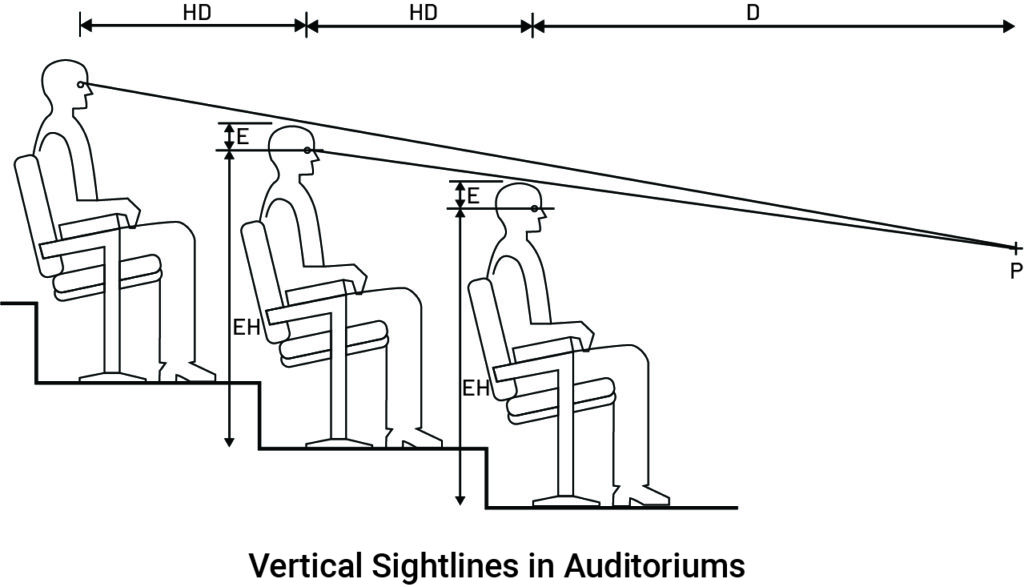
Horizontal Sightlines
- Horizontal sightlines restrict the width of the auditorium’s sitting area due to the specific dimensions and form of the stage. This is especially important when using slide, film, and video projection on a proscenium stage.
- The arc to view the entire platform or stage on plan is 40 degrees from the eye, as shown in Fig.
- A permissible head movement if the seat is focused away from the stage platform, such as with side galleries requiring the member of the audience to swivel their head, as shown in the figure, is debatable. [Source: Metric Handbook, 6th Edition]
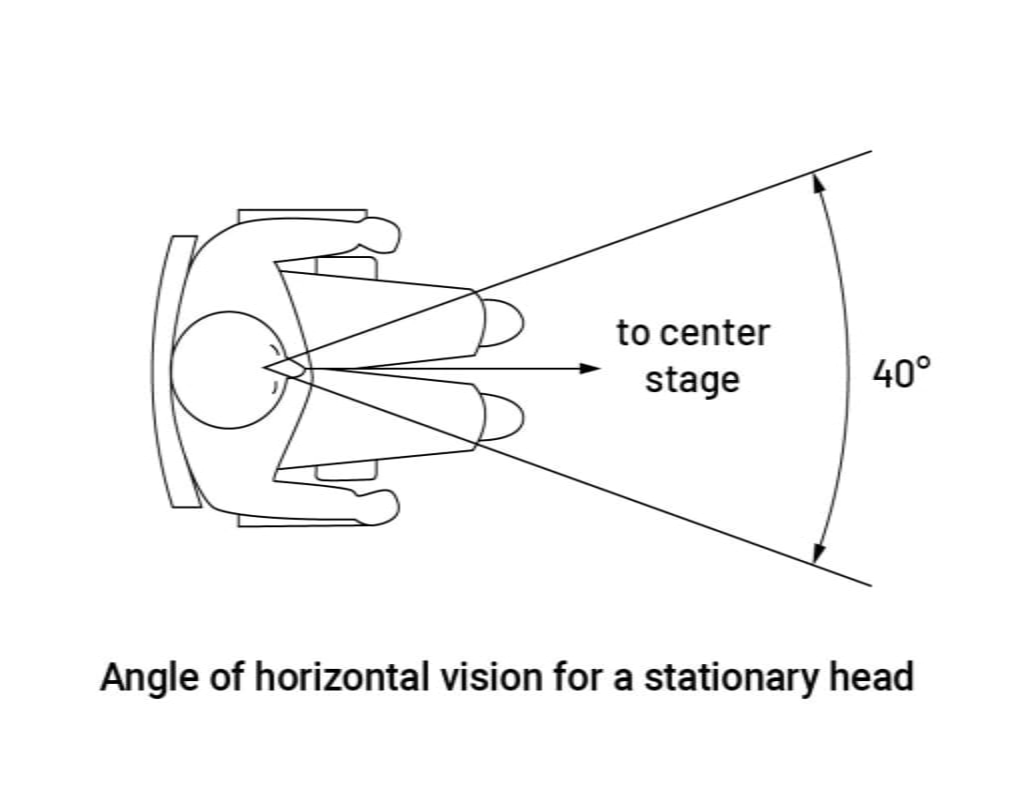


Seating Area
This should receive no incoming light except for emergency lighting. The walls and ceilings should be of non-reflecting material in relatively dark colors. The audience should sit within the outer edge of the screen. The viewing angle inside auditorium from the first row of seats to the center of the picture should not exceed 30°. Up to a 10% floor gradient is permissible, or steps with max. 160 mm (6.5 Inches) risers and aisles of 1200 mm (4 Ft.) in width. Up to 10 seats may be arranged on each side of the aisle. (Source: Neufert, 4th Edition).
An intermediary floor or platform protruding from the wall of an auditorium or hall to provide extra floor space and seating, for example, It must also incorporate the structures used for seats in stadiums. (Source: NBC Volume 1).
Gangways
- Gangways are designed for a smooth escape route out of the auditorium, and it is determined by the number of seats planned in the rows. A minimum of 1200 mm (4 ft.) of gangway is required.
- They can be ramped up to an incline of 10 percent (5.7° or 1:10), but only 8.5 percent (4.9° or 1:12) if they are likely to be used by people in wheelchairs.
- Gangways with steeper seating rakes must have full-width steps with risers and treads that are the same in each run.
- This means that the shallow curve created by sightline calculations needs to be changed to a straight line in order for the row-to-row spacing and row rise to be consistent with a practical gangway tread and riser. [Source: Metric Handbook, 6th Edition]
Auditorium and stage/acting area
Size of the auditorium: the number of people in the audience gives the required floor area. For seated spectators, assume ≥0.5 m2/ spectator. This number results from:
seat width x row spacing
≥0.45 m2 /seat
Add ≥0.5 x ≥0.9 =0.05 /seat
≥0.50 (Total)
Length of the rows of seats per aisle: 10 places , 25 places per aisle if an exit door of 1200 mm (4 Ft.) width is available at the side per 3 or 4 rows. Exits, escape routes 1200 mm (4 Ft.) wide per 200 people. 1% of the seats (at least two) must be accessible for wheelchair users, if possible in connection with a seat for an accompanying person.
Auditorium volume
This is determined by acoustic requirements (reverberation) p. 221 as follows: playhouse approx. 4-5 m3/spectator; opera house approx. 6-8 m3/spectator. Air volumes must not be less for technical ventilation reasons, to avoid too rapid air changes (draughts). (Source: Neufert , 4th Edition).
The volume of auditorium necessary per person should generally be between 3.5 and 5.5 m3. Suitable volumes for different types of auditoriums are given below, but it is recommended that higher values be adopted only in special cases:
| Spaces | Cubic meter per person |
| Public lecture halls | 3.5 to 4.5 |
| Cinemas or theatres | 4.0 to 5.0 |
| Musical halls or concern halls | 4.0 to 5.5 |
Proportions of the auditorium
These are derived from the psychological awareness and angle of view of the spectator, or the requirement for a good view from all seats. Options are:
- Good view, without moving head, but light eye movements of approx. 30°.
- Good view with slight head movements and light eye movements of approx. 60°.
- Max. awareness angle without head movement approx. 110°, i.e. all actions in the field are ‘in view’. Outside this field, there is uncertainty, because ‘something’ is out of view.
- Full head and shoulder movement allows an angle of view of 360° (Source: Neufert , 4th Edition).

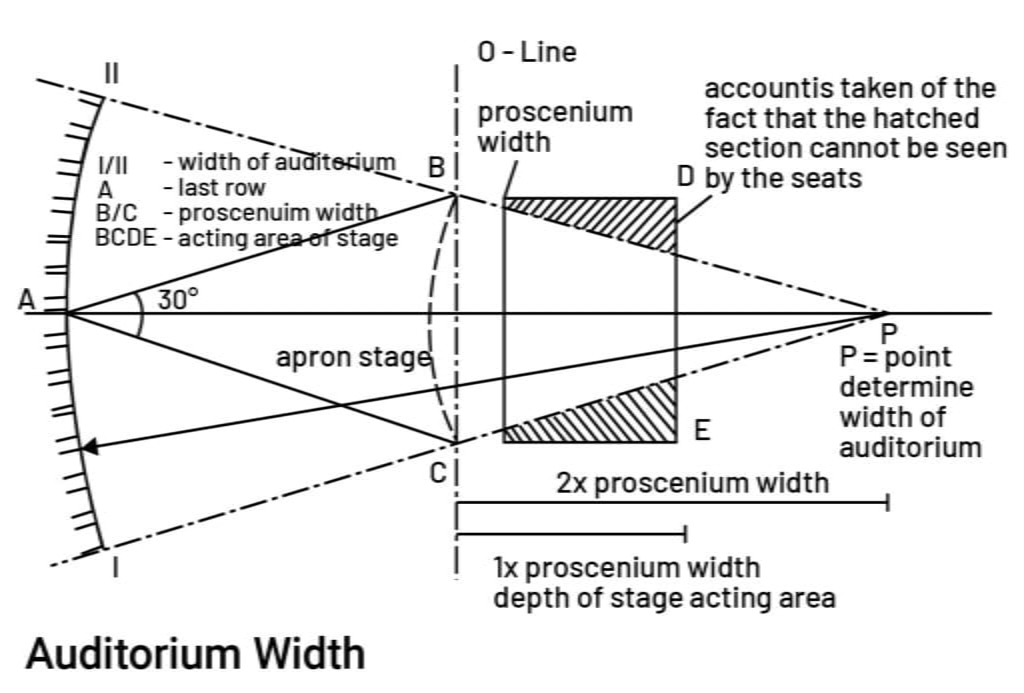
Proportions of Stage
Stage Forms
The size of the stage is determined by the sort of show that will take place in the hall. It would be enormous for theaters and comparably modest for cinema halls, depending on the size of the screen. [2] There are three types of stages: full stage, small stage, and set areas.
Full Stage
- More than 100 m2 of stage area. Stage celling is more than 1000 mm (40 inches) above the top of the proscenium arch.
- A full stage must have an iron safety curtain that divides the stage from the theater in the event of an emergency.
Small Stage
There is no stage extension (secondary stages) and no stage celling higher than 1000 mm (40 inches) above the top of the proscenium. Small stages do not necessitate the use of an iron safety curtain.
Set Areas
- Raised performing spaces in rooms where there is no ceiling projection. The restrictions on curtains and scenery are what distinguish set locations. They have an impact on the operation of specific areas rather than their planning.
- The experimental auditoria fall within the defined areas.
Stage Proportions
The lines of view in the theater are used to determine stage proportions. The stage area includes the playing area as well as walkways (around the back of the stage) and working places.
Stage Ventilation
Means should be provided for venting smoke and hot gases produced by a fire on the stage, such as the installation of a haystack lantern light or a fire ventilator located at the highest point in the roof over the stage and as close to the center of the stage as is reasonably practicable. An additional fresh air inlet may be beneficial. (Source: Neufert , 4th Edition).
Overall layout of the auditorium
Firstly, determine the height of the proscenium. In stall theaters, the relationship should be:
- proscenium height 1/ proscenium width 1.6
- This derives from the golden section and the physiological field of awareness, as shown in Fig. 1. After determining the proscenium height, the ramp height, the pitch of the stalls, and the volume of the room, this gives the room height. The ceiling is to be adapted for acoustic requirements. It should be the case that the noise reflected from the stage and apron is distributed evenly over the room, as shown in Fig. 2.
- For tiers, it is important that there is also a sufficiently deep view of the stage from the uppermost level. This may render it necessary to make the proscenium higher. (Source: Neufert , 4th Edition).
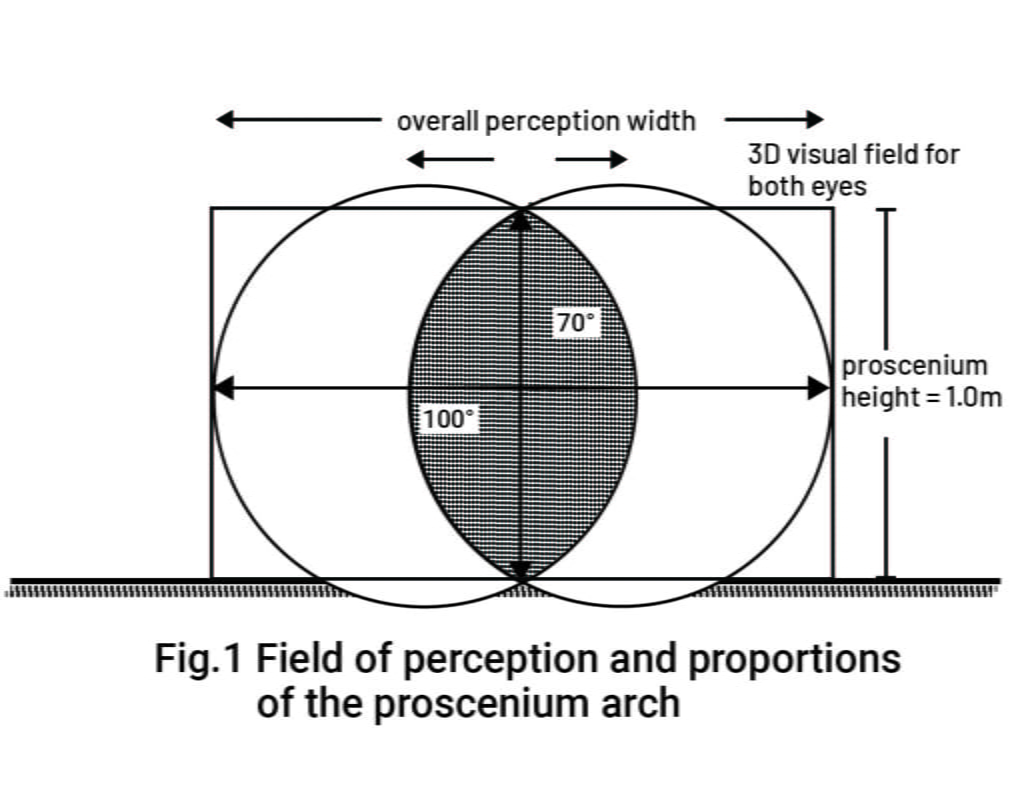
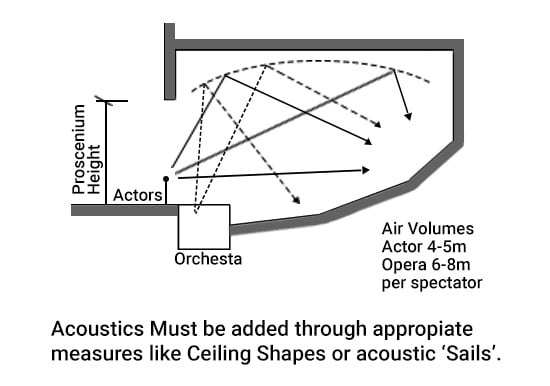
Rehearsal rooms
Every theatre needs at least one rehearsal stage to back up the main stage. For example, in a small theatre: the main stage has the scenery of the current play and the rehearsals take place on the rehearsal stage. The dimensions should correspond to the main stage. Typical floor plan of the rehearsal stage of a traditional theatre. Multi-purpose theatres and opera houses also require an orchestra rehearsal room, chorus rehearsal room, soloist rehearsal room and ballet room. (Source: Neufert , 4th Edition).
Experimental theatres
These also require, in reduced form, staff and rehearsal rooms, workshops and stores, if in continual operation. (Source: Neufert , 4th Edition).
Technical rooms
Rooms for transformer, medium- and low-voltage switchgear, emergency power supply batteries, air conditioning and ventilation plant, and water supply (rainwater system), according to local conditions and specialist design work. (Source: Neufert , 4th Edition).
Public rooms
The classical Italian opera had only narrow entrances and stairs, with no actual foyer. This makes the generous public rooms at the Grand Opera in Paris particularly impressive. The Vienna theatre fire in 1881 led to extensive changes: the audience is now required to have enclosed emergency stairs for each tier. This requirement continues in principle today (Public Assembly Regulations).
In the traditional theatre, the foyers are split into: the actual foyer (lobby), restaurant (buffet), and smoker’s foyer. The area of the foyers is 0.8-2.0 m2/spectator (more realistic is 0.6-0.8 m2/spectator). The function of the foyer has changed today: it must include provisions for exhibitions, performances, and regular plays there. (Source: Neufert , 4th Edition).
Cloakrooms
Per 100 visitors: 4 running m of rail. Sometimes lockers are also provided: one locker for every four visitors. The foyer is also a waiting and queuing room and has the usual extent of associated WCs: one WC/100 people. 1/3 gents, 2/3 ladies; min. one gents’ and one ladies’ WC. A total number of sanitary facilities should be designed as per the audience numbers.
Entrance hall (lobby) with day and evening cash desks, which should be opposite each other. (Source: Neufert , 4th Edition).
Other Design Considerations for Auditorium
Wheelchair Location
- Regulations requires a minimum of six places for wheelchair users, or 1/100th of the audience capacity, whichever if the greater.
- These spaces should be integrated among other seats and allow two wheelchair users to stay together. It is recommended that the armrests on the seats at the end of the row be lifted up to allow people to transfer from the wheelchair onto a seat. To accommodate groups of wheelchair users, in an auditorium with fixed seats, a minimum of 15 seats shall be foldable or removable to increase the number of designated areas for wheelchair users when necessary (Source: NBC Volume 1).
- Wheelchair positions need to be located on the level and should be located where there is direct and easy access.
- They can be located at the rear, front, side, or within the main seating areas of the auditorium, such as off a cross-gangway.
- Wheelchair users should be able to sit with a party of friends not in wheelchairs or with friends also using wheelchairs. [Source: Metric Handbook, 6th Edition]
Handrails and Balcony Fronts
- Any handrail should give firm support and allow a firm grip.
- Steeply raked seating (in excess of 25°) should have hooped rails or similar supports at the end of rows with gangways.
- The balcony handrail height should be 900 mm (36 inches) in front of fixed seats and 1200 mm (48 inches) at gangway ends.
- Balcony fronts are used to support stage lighting and require socket outlets that are linked to stage lighting controllers. [Source: Metric Handbook, 6th Edition]
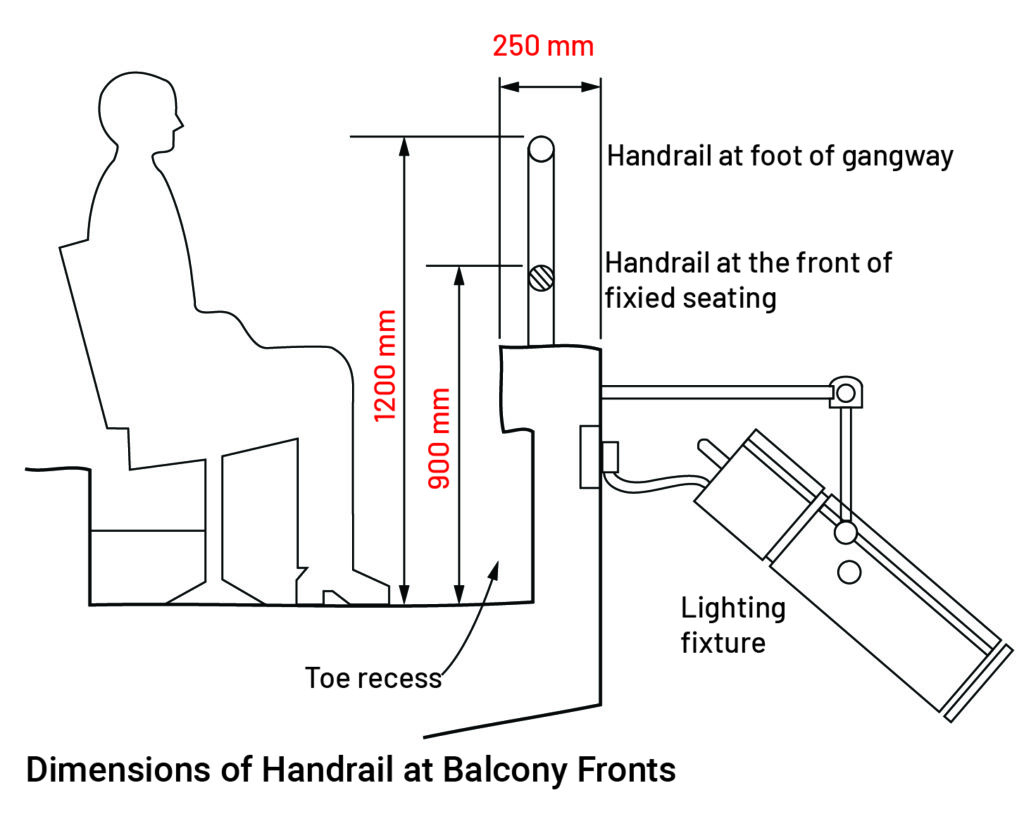
Means of Escape
The lobby’s and corridors traffic flow is crucial since it has to manage a huge audience coming in and out of the house. Consider how many people your auditorium can accommodate. The goal is for everyone in the auditorium to be able to evacuate to a safe location within a certain amount of time. The escape route is from the seat, via the clearway and gangway, and immediately through exit doors, or through an enclosed hallway, to a secure location.
Travel Distance
- In an auditorium with fixed seated rows, a maximum travel distance of 15 m in one direction is permissible, with 32 m as a limit when escape is possible in two directions (of which only 15 m can be in any one direction).
- The requirement to evacuate from every level of the auditorium in less than two and a half minutes sets the maximum travel distance from seat to exit.
- The maximum travel distance for continental seating is 15 m from any seat, whereas for conventional seating it is 18 m from the gangway.
Exits
For every 500 seats, there must be two distinct exits from each auditorium level, and for every extra 250 seats, there must be an additional exit.
| Number of Peoples | Minimum Total Exit Width |
| Up to 200 | 2200 mm (7 Ft.) |
| 201 – 300 | 2400 mm (8 Ft.) |
| 301 – 400 | 2800 mm (9 Ft.) |
| 401 – 500 | 3200 mm (11 Ft.) |
| 501 – 750 | 4800 mm (16 Ft.) |
| 751 – 1000 | 6400 mm (21 Ft.) |
| 1001 – 2000 | 14400 mm (48 Ft.) |
| 2001 – 3000 | 20800 mm (70 Ft.) |
Exits Routes
- Adequate signage, lighting, and guidance to help people locate their exits, and facilities will make crowd movement safer and more efficient.
- Escape routes should be uniform in width and no less than the width of the exit, but they can widen in the direction of escape.
- Fire-resistant enclosures should be installed on all internal routes. All doors that open onto fire escape routes must meet specific specifications.
- Exit doors should be no less than 1200 mm (48 inches).
Stairs
- A flight width of at least 1200 mm (48 inches) is recommended.
- A flight shouldn’t have more than 10 to 12 steps in one go.
- The tread and risers of the stairs should be 300 mm (12 inches) and 150 mm (6 inches).
Ramps
- A minimum of 1:20 slope should be provided for the ramp. (1:16 slope can be a comfortable option).
- A ramp should have a headroom of 2400 mm (8 ft).
- Wheelchair users should have access to flat or ramped routes that are separate from other routes. Ramps should not be longer than 4500 mm (15 ft.) in length or steeper than 8.5% in grade.
Refuge Area
- Accessed in the direction of escape
- Located in a protected corridor, a protected lobby, or a protected room adjacent to a protected stair. [Source: Metric Handbook, 6th Edition]
Circulation
While gangway lengths and widths are estimated as part of the fire escape route, they also enable circulation within the auditorium, with extra gangways from audience entry points to individual rows and seats if necessary. [Source: Metric Handbook, 6th Edition]
Sound insulation from outside noise sources
The standards are expressed as a noise rating (NR). To achieve the appropriate rating for auditorium design may require:
- Isolation of the auditorium structurally
- Sound locks all doors at the point of entry.
- Services are acoustically sealed.
- Noise reduction in air conditioning, heating, and ventilation systems. [Source: Metric Handbook, 6th Edition]
Sound Absorbing materials for auditorium
The materials that are commonly utilized can be broadly classified as follows:
- Acoustic plaster (a cement-based plaster containing granulated insulating material).
- Compressed cane or wood fiberboard, unperforated and perforated;
- Wood particle board;
- Compressed wood wool
- Mineral or glass wool quilts and mats;
- Mineral or compressed glass wool tiles;
- Composite units of perforated hardboard backed by perforated fiberboard;
- Composite units of perforated board (hardboard, asbestos board, or metal sheet) backed by a mineral or glass wool quilt or slab;
- Special absorbers constructed of hardboard, teak ply, etc. backed by air. [Source: IS Code: 2526]
Ventilation, heating, cooling and air conditioning
- The design is determined by the auditorium’s internal standards, the enclosure’s thermal insulation, and the external climatic circumstances.
- To achieve comfort conditions, ventilation must give fresh air at a rate of change; the rates are defined by the government and contain a fraction of recycled air that varies locally.
- A common condition is an 8-liter-per-second minimum air supply per person, with 75 percent outside air and 25 percent recirculated air.
- Extract ductwork can be at the ceiling level and under balconies, with supplies below the seating.
- Plants should be remote from auditoriums to avoid noise transmission. [Source: Metric Handbook, 6th Edition]
Lightings
There are six kind of lighting is required for the auditoriums:-
Performance Lighting
- Lighting conditions that support lip reading and sign language should be provided. The environment should be designed to avoid reflection and glare, and it should be possible to adjust both natural and artificial light.
- Lighting is an essential component of production staging for theater, opera, and dance performances. With lighting places not just on the stage, but also on the ceiling, side and rear walls, and balcony fronts.
- For classical music and serious jazz, adequate illumination is usually sufficient to let the performers to see their music and the conductor (if any), as well as to be seen by the audience.
- At conferences, similar lighting is required for the platform.
- Pop music necessitates lighting that is as complicated as that required for drama and opera, if not more so with intricate effects.
House lighting before and after performance and during intervals
- Illumination is needed to enable the audience to move around, find their seats, and read programs. Decorative lighting also enhances architectural features and shapes the overall ambiance of the space.
- This type of lighting is also required for conferences.
House lighting during performance
- Lighting during performances in cinema is used for exit indicators and escape pathways.
- A slightly higher amount of illumination may be employed for theater, especially if the performance requires a contrast with a period of almost absolute darkness.
- It is currently standard for classical music to have adequate lighting for near-normal vision and the following scores.
- House lighting as sophisticated as performance lighting, including strobe, moving, and laser light capabilities, may be required for pop music.
- Certain levels of lighting are essential during performances to ensure safety in the event of an emergency, particularly along escape routes.
- Each light fitting can include a battery and be programmed to turn on when the power source fails.
Working lighting at other times
The seating area will also require a brighter working level of lighting for cleaning, maintenance, and probably during rehearsals and auditions.
Front-of-house lighting
Escape routes must be adequately lit at all times during the performances, as well as before and after. To enhance their beauty, foyers, bars, and ticket offices require inventive lighting design.
Backstage lighting
- Backstage corridors are often used as escape routes for performers and service staff and must be kept illuminated whenever the building is occupied.
- Dressing rooms and workshops will have standard lighting and may be equipped with proximity detectors to ensure that lights are not left on while the rooms are empty.
- Doors leading to the stage may require special low-level blue lighting elements to avoid trip hazards and so that light does not spill into the stage area during a performance. [Source: Metric Handbook, 6th Edition]
Fire Protection
Guidelines for fire safety should be discussed with the authorities, and with their assurance, anything can be concluded. However, these are some important measures that should be taken care of:
Preventing fires from occurring
- Use non-combustible materials for the accessories, finishing, and seating.
- double-layer protection of electrical circuits
- Separate or far-away zones for hazardous things
Detecting Fire Before It Arises
- Install smoke, heat, and gas detectors inside the auditorium and backstage.
- The alert alarm system is connected to the automatic detectors. These should be visible (flashing light), but the auditorium is not audible.
Preventing them from spreading
- Construct the enclosure walls, floors, etc. with fire-rated materials.
- Install self-closing fire doors and T-90 or T-180 fire-rated doors.
Facilitating Extinguishing
- Hose-reels
- Portable Extinguishers
- Automatic Sprinkler System (except above the seating area) [Source: Metric Handbook, 6th Edition]
Ceiling Zone
Functional requirements cover:
- Acoustics: profiled reflector panels and possible adjustable diffusers. For non-amplified music, reflectors are also available over the concert platform.
- Lighting: bridges for access and support for auditorium lighting, working lights, emergency lighting, and performance lighting
- Ventilation: air ducts and plenums, diffusers, noise attenuation and monitoring equipment, supporting hangers, and means of access for servicing
- Production requirements: for operas, dance musicals, and drama, a grid and pulley suspension for suspending scenery over forestage, including access by technicians
- Fire control: detection system in voids and fire dampers in ducts and
- Structure: support for the roof, ducts, lighting bridges, etc. [1]
- In large halls, a false ceiling is usually provided below the trusses.
- The portion of the false ceiling near the proscenium is constructed of reflective material (usually plaster of Paris) and is suitably inclined to help reflections from the stage reach the rear seats of the hall.
- The remaining portion of this ceiling is constructed to undergo acoustical treatment.
- Concave-shaped ceilings (in the form of domes or barrels) should be avoided.
- The rear portion of the ceiling may be treated with sound-absorbing material, partly for control of reverberation and partly to prevent the buildup of audience noise.
- The ceiling can be flat, although a modest increase in height around the center of the hall is preferable. [Source: IS Code: 2526]
*Note: The dimensions written in feet, inches and mm are individual dimensions, not converted.











